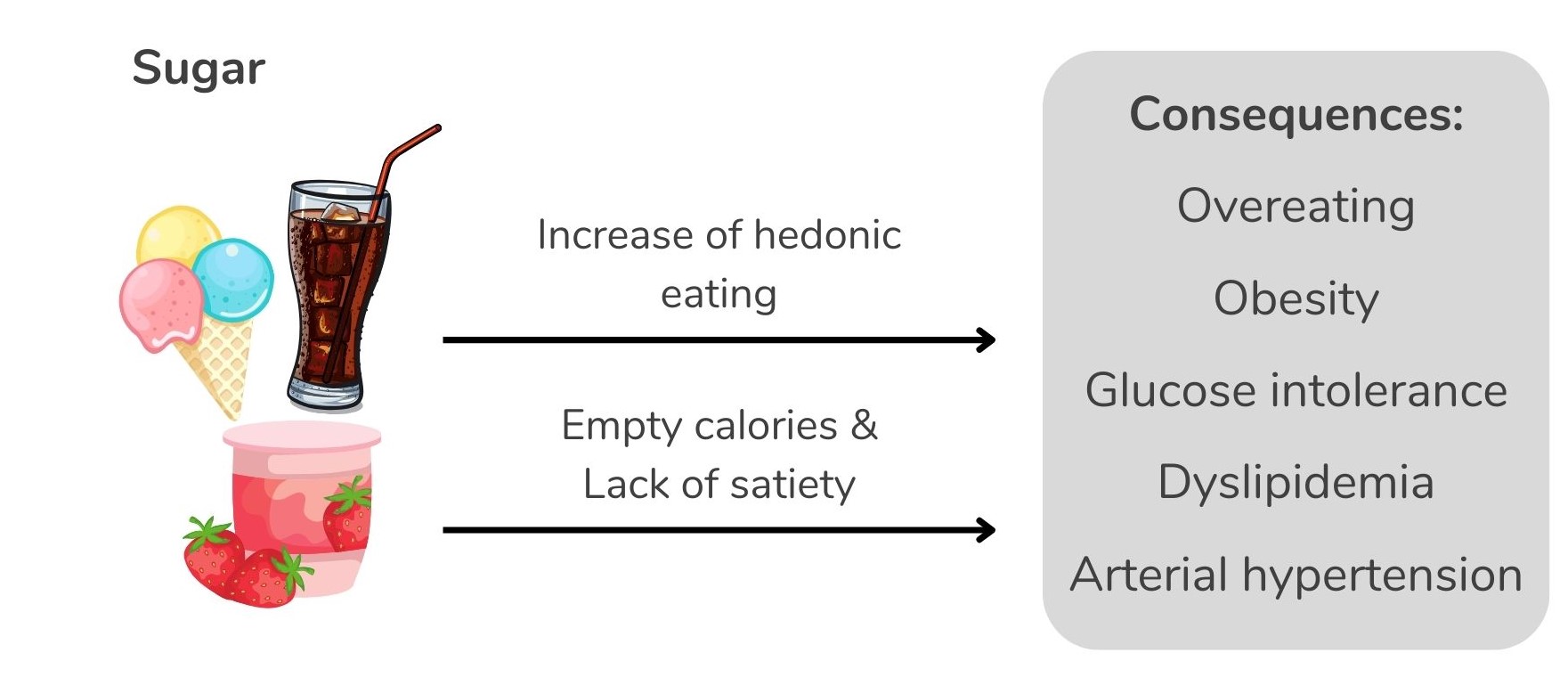
Major points:
- Neatic focuses on sugars that are added to foods during production and sugars naturally present in honey, syrups, fruit juices, and fruit juice concentrate.
- These sugars cause overeating because they make food super tasty, and because sugar calories especially in beverages escape your body’s energy monitoring.
- Neatic limits sugar consumption to 280 g per week which is an average of 40 g per day. Only sugars that appear in the first three positions of the ingredient list are taken into account.
What is sugar?
Neatic defines the term “sugar” as all mono- and disaccharides that are added to food during production, including table sugar, glucose, and fructose. Sugars that are naturally present in honey, syrups, fruit juices, and fruit juice concentrate are also included in this definition. For simplicity, Neatic uses the term “sugar” instead of the scientifically correct term “free sugars”.

Why is sugar used by the food industry?
There are several reasons for the use of sugar in food.
It creates a sweet taste in food that many people find irresistible. Especially sugar-sweetened beverages offer a super tasty combination of sugar and added flavors in liquid form. Sugar improves the volume and consistency of food. When baking and frying, sugar helps to form an attractive brown crust. Small amounts of sugar can enhance the flavor of food and mitigate sour and bitter tastes. Sugar also serves as a preservative by removing moisture from food.
Sugar is cheap to produce. This was not always the case: For millennia, sugar was a calorie-laden luxury item. In the Middle Ages, sugar was called white gold. In 1822, an average of 8 g of sugar was consumed per day in the USA, while today the consumption has increased to 70 g of sugar per day.
Sugar-sweetened beverages contribute significantly to this increase in sugar consumption. In the USA, their consumption increased fourfold between 1965 and 2002, from 9 g of sugar (equivalent to approx. 90 ml of sugar-sweetened beverages) to 36 g of sugar (equivalent to approx. 360 ml of sugar-sweetened beverages) per day.
How does sugar cause overeating and obesity?
Sugar creates a delicious sweetness in food and makes it irresistible. You eat more, even though your calorie requirement has long been met. This eating for pleasure is called hedonic eating.
Sugar increases hedonic eating!
Sugar, especially in beverages, escapes the body’s energy monitoring. Although sugar-sweetened beverages contain a lot of calories, these calories are not adequately perceived by the body. As a result, you consume more calories than you need and still do not feel full. These additionally consumed calories are called empty calories.
Especially in sugar-sweetened beverages, sugar escapes the body’s energy monitoring!
The fact that sugar causes overeating and obesity is not just theory: as far back as 1972, the English physiologist and nutrition scientist John Yudkin warned of the dangers of sugar based on research data. Forty years later, the World Health Organization (WHO) published a summary of previous studies on sugar intake and body weight. The result was clear: increased sugar consumption causes weight gain. Increased sugar intake also contributes to high blood pressure and lipid metabolism disorders. Consequently, the WHO recommends limiting sugar to less than 10 % of total calorie intake, which corresponds to 50 g of sugar per day for a daily intake of 2000 kcal.
In animal studies, it has been convincingly demonstrated that an addictive craving for sugar can occur. In experiments, animals continually increased their sugar consumption and experienced withdrawal symptoms when sugar was not readily available.
What does Neatic recommend concerning sugar?
In Neatic, sugar is limited due to its weight-increasing effects. The approach is summarized in Principle 3.
Principle No. 3
Limit sugar to 280 g per week, which is an average of 40 g per day. Only sugars that appear in the first three positions of the ingredient list are taken into account.
But remember: Neatic does not limit sugars in fruits in any way, as long as they are eaten in their edible entirety. Neatic also allows the consumption of complex carbohydrates, for example in grains, legumes, and potatoes.
If you would like to find out more about the different types of sugar, click here.

Bibliography:
Camps, Guido; Mars, Monica; Graaf, Cees de; Smeets, Paul am (2016): Empty calories and phantom fullness: a randomized trial studying the relative effects of energy density and viscosity on gastric emptying determined by MRI and satiety. In: Am J Clin Nutr 104 (1), S.73–80. DOI: https://doi.org/10.3945/ajcn.115.129064.
Duffey, Kiyah J.; Popkin, Barry M. (2007): Shifts in patterns and consumption of beverages between 1965 and 2002. In: Obes 15 (11), S.2739–2747. DOI: https://doi.org/10.1038/oby.2007.326.
Martínez Steele, Eurídice; Baraldi, Larissa Galastri; Da Louzada, Maria Laura Costa; Moubarac, Jean-Claude; Mozaffarian, Dariush; Monteiro, Carlos Augusto (2016): Ultra-processed foods and added sugars in the US diet: evidence from a nationally representative cross-sectional study. In: BMJ 6 (3), e009892. DOI: https://doi.org/10.1136/bmjopen-2015-009892.
Raatz, Susan (2019): The Question of Sugar. Available online at https://www.ars.usda.gov/plains-area/gfnd/gfhnrc/docs/news-articles/2012/the-question-of-sugar/, last checked 26.03.2025.
Taubes, Gary (2018): What if sugar is worse than just empty calories? An essay by Gary Taubes. In: BMJ 360, j5808. DOI: https://doi.org/10.1136/bmj.j5808.
Te Morenga, Lisa; Mallard, Simonette; Mann, Jim (2012): Dietary sugars and body weight: systematic review and meta-analyses of randomised controlled trials and cohort studies. In: BMJ 346, e7492. DOI: https://doi.org/10.1136/bmj.e7492.
Te Morenga, Lisa A.; Howatson, Alex J.; Jones, Rhiannon M.; Mann, Jim (2014): Dietary sugars and cardiometabolic risk: systematic review and meta-analyses of randomized controlled trials of the effects on blood pressure and lipids. In: Am J Clin Nutr 100 (1), S.65–79. DOI: https://doi.org/10.3945/ajcn.113.081521.
Wiss, David A.; Avena, Nicole; Rada, Pedro (2018): Sugar Addiction: From Evolution to Revolution. In: Front Psychiatry 9, S. 545. DOI: https://doi.org/10.3389/fpsyt.2018.00545.
World Health Organization: Guideline: sugars intake for adults and children. Available online at https://www.who.int/publications/i/item/9789241549028, last checked 19.10.2022.
Yudkin, John (1972): Sweet and Dangerous: Peter H. Wyden, Inc. ISBN: 978-0883260500.
